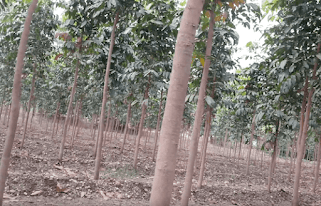Sagwan Farming
Sagwan (Tectona grandis) is one of the most well known timbers of the world. And it belongs to verbenaceae family. It knows as the “Burmese teak“. Tectona grandis is a large, deciduous tree that occurs in mixed hardwood forests. It has small, fragrant white flowers and large papery leaves that are often hairy on the lower surface. Generally, a teak plant grows to a height 25-30 ft and attains a girth of 30-35 inches. Sagwan prefers moist, warm tropical climate. It can withstand extremes of temperature, but maximum and minimum shades temperature of 39 to 440 °C and 13 to 170 °C respectively are most favorable for its growth. It grows well in rainfall zone of 1200-2500 mm. Teak grows best on deep, well-drained alluvial soils derived from limestone, schist, gneiss, shale and some volcanic rocks, such as basalt. The ph range of soil in teak forest is wide (5.0 to 8.0) and the optimum ph range for better growth and quality is between 6.5 to 7.5. Several researches found Teak soil is relatively fertile with high calcium , phosphorus , potassium , nitrogen and other organic matter. Although sagwan has been named as calcerous species. The amount of calcium in teak plant is also indicator of quality of teak site quality. Sagwan Farming is popularly growing concept in the Farming Sector. We are Sagwan Cultivators and Sellers in Rajasthan & Gujarat, and are providing. We integrate teak and eucalyptus & popular plantation in india . Tissue culture Teak plants (Hybrid nursery plant) site surveys, guide, and soil check up to complete your project of teak farming (Sagwan) Plantation. With international boycotts on harvesting natural teak the only alternative supply is cultivated plantations. At just six months growth of teak trees are already approximately 12-15 feet high. Carbon is removed from the atmosphere and stored in the wood at very high levels. Project dependent this may give teak additional value on the future carbon markets as the world moves to a carbon-indexed economy. Pest and diseases management 1Termites :- Gain entry from the injured part of the roots/stem near the ground and seriously damaged the xylem, often resulting in the death of the plants. Treated with chloropyriphos 2.5 ltr. per acre or 4 to 5ml per plants twice in a year with frequent irrigation should be arranged. 2. Stem Borer :- Spread Phorate – 10G with 8kg per acre upto second year of plantation or inject kerosene oil in stem 2 to 5 ml per hole. 3. Pygeria :- Spray Carbyl 50%w.P 250 – 300gm with 2 ppm ratio or 400 – 500ml Monocrotophos 36SL per acre. 4. Bark Insects :- Bordeaux paste upto 4 feet from ground level in month of march. 5. Leaf Defoliators :- Spray Monocrotophos 500 – 600ml, Chloropyriphos + cypermethrin 750ml, Lara or Hiltron 1.5% V.V. per acre. Attack noticed in month of July. 6. Mites :- Spray with 2ml Roger 30 E.C or Matasystox per ltr of water and to be repeated after interval of 15 days. DISEASES 1. Color Rot :- Color Rot cause death of plants through roots. Treat roots with Emisan -6, 4 to 5gm per plant in deep root zone area. 2. Wilt :- It seems first time in Poplar plantation during May & June. Spray with 500 gm per acre sulphar-80% W.P with frequent irrigation in these months. DEFICIENCIES 1. Zink Deficiency :- Its quite common in many areas and its shown yellowing of intervenal space of the leaves. Zink Sulphate – 21% applied with 10kg per acre.




Comments
Post a Comment
आप के सुझाव हेतु धन्यवाद.